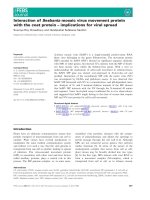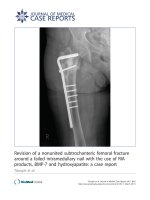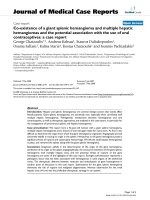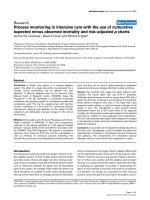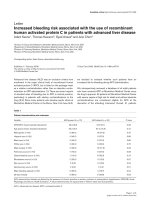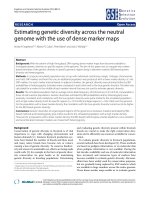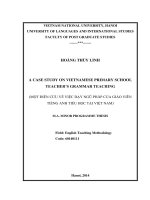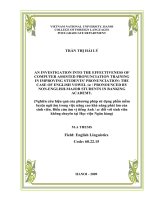effectiveness of teaching grammar with the use of dictogloss for students of k37a maths class, at hanoi college of education = hiệu quả dạy ngữ pháp bằng phương pháp dictogloss cho sinh viên lớp sư phạm
Bạn đang xem bản rút gọn của tài liệu. Xem và tải ngay bản đầy đủ của tài liệu tại đây (1.73 MB, 145 trang )
VIETNAM NATIONAL UNIVERSITY, HANOI
UNIVERSITY OF LANGUAGES AND INTERNATIONAL STUDIES
FACULTY OF POSTGRADUATE STUDIES
---- ----
NGUYỄN THỊ HẰNG
Effectiveness of Teaching Grammar with the Use of
Dictogloss for Students of K37A Maths Class, at Hanoi
College of Education: An Action Research
Hiệu quả Dạy Ngữ pháp bằng Phương pháp Dictogloss cho
Sinh viên lớp Sư phạm Toán 37A, Trường Cao đẳng Sư
phạm Hà Nội: Nghiên cứu tác động
(M.A THESIS)
Field: English Language Teaching Methodology
Code: 60.140.111
HANOI - 2014
VIETNAM NATIONAL UNIVERSITY, HANOI
UNIVERSITY OF LANGUAGES AND INTERNATIONAL STUDIES
FACULTY OF POSTGRADUATE STUDIES
---- ----
NGUYỄN THỊ HẰNG
Effectiveness of Teaching Grammar with the Use of
Dictogloss for Students of K37A Maths Class, at Hanoi
College of Education: An Action Research
Hiệu quả Dạy Ngữ pháp bằng Phương pháp Dictogloss cho
Sinh viên lớp Sư phạm Toán 37A, Trường Cao đẳng Sư
phạm Hà Nội: Nghiên cứu tác động
(M.A THESIS)
Field: English Language Teaching Methodology
Code: 60.140.111
Supervisor: Dr. Ngơ Hữu Hồng
HANOI - 2014
CERTIFICATE OF ORIGINALITY
I, the undersigned, hereby certify my authority of the study project report entitled:
“Effectiveness of Teaching Grammar with the Use of Dictogloss for Students of
K37A Maths Class, at Hanoi College of Education: An Action Research”
submitted in partially fulfillment of the requirements for the degree of MA in
English Language Teaching Methodology.
Except where the reference is indicated, no other person‟s work has been used
without due acknowledgement in the text of the thesis.
Student‟s name
Nguyễn Thị Hằng
In my capacity as supervisor of the candiate‟s thesis, I certify that the above
statements are true to the best of my knowledge.
Supervisor
Dr. Ngơ Hữu Hồng
Hanoi, February 9, 2014
i
ACKNOWLEDGEMENTS
My thesis cannot be completed without generous instructions and assistance of
several people as follows:
My first genuine thanks must be given to Dr. Ngo Huu Hoang, who guided me as a
very dedicated instructor. He is the person who gives me suggestions for my paper‟s
major as well as supplies me with various information sources. He was unfailingly
available for my questions and concerns, and always ready with thoughtful
suggestions and valuable insights. With his special expertise, he provided me with
expensive advice, encouragement, and careful guidance.
I wish to acknowledge the support of all students in K37A Maths class for their
continuous cooperation. Thanks to them, I was able to carry out my thesis and
collect data.
Last, much gratefulness is offered to Ms. Nguyen Quynh Trang for her great
enthusiasm and assistance during the very first stage as well as during the process of
thesis development. To Ms. Nguyen Thi Bich Lien and Ms. Hoang Kim Thu, two
English lecturers at Hanoi College of Education, I appreciate their invaluable advice
and recommendations for better implementation of Dictogloss in classroom.
ii
ABSTRACT
This action research is aimed at examining the effects of dictogloss on the students‟
grammatical competence and motivation for learning grammar.
To fulfill this aim, 28 students of K37A Maths class and two teachers at NonEnglish major Division, HCE were choosen to take part in the 12-week research.
Five instruments were employed, namely qualitative analysis of textbook,
observation, tests (entry test, a pre-test and a post-test), questionnaires (a prequestionnaire and a post questionnaire), and interviews in order to gather the data.
The initial data indicated that the students‟ poor grammatical competence and low
motivation in learning grammar may be attributed to their exposure of uninteresting
and linear teaching method in the class. On the basis of the findings, it was
hypothesized that “Applying dictogloss which can be appropriate for the students’
level would raise the students’ interest and grammatical competence”. An
evaluation of the action research study was made by comparing with the data
collected by means of post-data collection instruments. The analysis revealed that
the use of dictogloss in the grammar lessons improves not only their grammatical
competence but also their attitudes towards learning grammar.
iii
LIST OF ABBREVIATIONS
CLT: Communicative Language Teaching
EFL: English as a Foreign Language
ELT: English Language Teaching
FonF: Focus on Form
HCE: Hanoi College of Education
L2: Second Language
MA: Master of Arts
SLA:Second Language Acquisition
Ss: Students
T: Teachers
TEFL: Teaching English as a Foreign Language
iv
LIST OF TABLES
Table 1: Basic procedure of dictogloss in class
Table 2: Target grammatical points to be taught
Table 3: Students‟ evaluation on topics
Table 4: Comparison the students‟ performance in pre-test tasks
Table 5: Students‟ responses on the importance of grammar
Table 6: Students‟ responses to traditional grammar-teaching classes
Table 7: Comparison the students‟ performance in post-test tasks
Table 8: Comparison of students‟ performance on task 5 in pre and post-test
Table 9: Students‟ attitudes to dictogloss technique
v
LISTS OF FIGURES
Figure 1: Action research cycle
Figure 2: Students' results of the entry test
Figure 3: Students‟ results of the pre-test
Figure 4: Teachers‟ usual way of teaching grammar in the previous semesters
Figure 5: The results of the post-test
Figure 6: Comparison of pre-test‟s and post-test‟s results
Figure 7: Comparison of students‟ performance on task 1 in pre and post-test
Figure 8: Comparison of students‟ performance on task 2 in pre and post-test
Figure 9: Comparison of students‟ performance on task 4 in pre and post-test
Figure 10: Students‟ evaluation on their grammar improvement
Figure 11: Students‟ attitudes to learning grammar
vi
TABLE OF CONTENTS
ABSTRACT ...........................................................................................III
LIST OF ABBREVIATIONS .............................................................. IV
LISTS OF FIGURES ............................................................................ VI
PART A: INTRODUCTION ................................................................. 1
1. Rationale ................................................................................................................. 1
2. Aims of the study .................................................................................................... 2
3. Scope of the study ................................................................................................... 3
4. Significance of the study ......................................................................................... 3
5. Overview of the thesis ........................................................................................... 4
PART B: DEVELOPMENT .................................................................. 5
CHAPTER 1: LITERATURE REVIEW ................................................................ 5
1.1. Theoretical background..................................................................................... 5
1.1.1. Grammar teaching .......................................................................................... 5
1.1.1.1. Grammatical competence ............................................................................... 5
1.1.1.2. Changing views of grammar Instruction ........................................................ 6
1.1.1.3. Ways of teaching grammar ............................................................................ 9
1.1.1.4. Principles of teaching grammar ................................................................... 10
1.1.2. Dictogloss ....................................................................................................... 12
1.1.2.1. Dictogloss and its relation with grammar teaching ...................................... 12
1.1.2.2. Procedure of Dictogloss ............................................................................... 14
1.1.2.3. Dictogloss variations .................................................................................... 16
1.1.2.4. Factors influencing learners‟ performance on Dictogloss ........................... 19
vii
1.1.3. Motivation ...................................................................................................... 21
1.1.3.1. Definition of motivation ............................................................................... 21
1.1.3.2. Types of motivation ..................................................................................... 21
1.1.3.3. Roles of motivation in teaching and learning a language ............................ 22
1.1.3.4. Factors affecting motivation ........................................................................ 22
1.2. Previous studies ................................................................................................ 23
1.3. A summary ........................................................................................................ 28
CHAPTER 2: METHODOLOGY ......................................................................... 30
2. 1. Action research ................................................................................................ 30
2.1.1. Definition of action research * ........................................................................ 30
2.1.2. Rationale for choosing action research ........................................................... 31
2.1.3. Process of action research ............................................................................... 32
2.2. Participants of the study .................................................................................. 37
2.2.1. The students .................................................................................................... 37
2. 2. 2. The teachers .................................................................................................. 38
2.3. Data Collection Instruments ........................................................................... 38
2.3.1. Qualitative analysis of textbook “New English file – Pre-intermediate” ....... 38
2.3.2. Class observation ............................................................................................ 39
2.3.3. Tests ................................................................................................................ 40
2.3.4. Questionnaires ................................................................................................. 42
2.3.5. Interviews ........................................................................................................ 43
2.4. Procedure of dictogloss in class ....................................................................... 45
2.4.1. Basic procedure of dictogloss in class ............................................................ 45
2.4.2. Variations of dictogloss in class ...................................................................... 46
viii
2.5. A Summary of Methodology ........................................................................... 46
CHAPTER 3: FINDINGS AND DISCUSSION ................................................... 48
3.1. Initial data ......................................................................................................... 48
3.1.1. Analysis of the entry test ................................................................................. 48
3.1.2. Analysis of Text book “New English Files – Pre-intermediate” .................... 49
3.1.3. Data from the Pre-test ..................................................................................... 51
3.1.4. Data from the pre-questionnaire ..................................................................... 54
3.1.5. Data from the first interview for students ....................................................... 57
3.2. Post data ............................................................................................................ 58
3.2.1. Data from the interview for teachers ............................................................... 58
3.2.2. Data from the Post-test .................................................................................... 60
3.2.3. Data from the post-questionnaire .................................................................... 65
3.2.4. Data from the post-interview for students....................................................... 69
3.2.5. Observation ..................................................................................................... 71
3.3. A summary of findings..................................................................................... 73
PART C: CONCLUSION .................................................................... 74
1. Conclusion............................................................................................................ 74
2. Implications for teaching....................................................................................... 75
3. Limitations ............................................................................................................ 78
4. Suggestions for further study ............................................................................. 79
REFERENCES ...................................................................................... 80
APPENDIX 2: OBSERVATION SHEET ........................................ XII
APPENDIXES .......................................................................................... I
ix
PART A: INTRODUCTION
1. Rationale
Grammar has long rooted in the curriculum of English Language Teaching (ELT),
with no or very little introduction of speaking and listening. From its first
introduction, grammar was seen as “the center of language pedagogy” and teachers
were encouraged to take as much grammar input to the students as possible
(Nassaji, H and Fotos, S, 2011:2), so in general, the students were totally or mostly
exposed to taught-in-isolation grammar lessons. By that way, they gradually felt
demotivated in such traditional classes.
By contrast, in the 1970s, the rise of Communicative Language Teaching (CLT) led
to a tendency of de-emphasizing the role of grammar in classes although it is
believed to be “a means to improving master of the language” (Penny Ur, 1991:78).
Many teachers are more likely to orient students to such English skills as speaking
and listening. Unfortunately, in the absence of grammar, it is hard for learners of
English to acquire accuracy in producing English (Francis J. Noonan III, 2004).
Teaching grammar, therefore, has become a challenging and boring task for many
teachers and likewise learning grammar seems to be a burden for learners. Grammar
lessons often go boring in English classes and achieve less efficiency. The context
of Non-English major Division, at Hanoi College of Education (HCE) is not an
exception. Non-English major students are assessed to be poor at grammatical
competence. Through long courses of grammar, they are still generally weak at
producing the correct sentences using the perceived language points. In addition,
they appear to express low interest in pure grammar lessons. Meanwhile,
researchers reach a consensus that grammar is too important to be ignored; in
absence of good knowledge of grammar, “learners‟ language development will be
severely constrained” (Hedge, 2000). It is also widely agreed by language
practitioners and theoreticians on the significance of developing learners‟
1
grammatical accuracy (Dickins & Woods, 1988 cited in Storch, 2001). That is why
grammar is chosen to be focused at Non-English major Division, HCE. The tests for
non-English major students at HCE are considerably composed of grammar items.
Be aware of the situation, the researcher finds that there is a need for a teaching
technique which could address the students‟ two primary problems: Poor
grammatical competence and low motivation for learning grammar.
Teaching grammar in an interesting and communicative way has been always given
some concern by the practitioners of Teaching English as a Foreign Language
(TEFL) in general, and even the author of this study in particular. While many
attempts have been given to this task, there is still room for more attention to
innovative methods of grammar instruction which gives chance for learners to
practice grammar via working on a combination of meaning and form which makes
grammar learning more meaningful. Dictogloss, one of the recently-developed
techniques, is introduced as an alternative method of teaching grammar (Wajnryb,
1990). It is claimed to encourage learners to concentrate on the form of language on
basis of communication (Ellis, R, 2003:156–157). This seems to be appropriate for
its application into the English course at Non-English major Division, HCE because
in the textbook “New English file – pre-intermediate”, it can be observed that each
file centers on grammar section, on which almost other parts are based. This is the
inspiration for the researcher to carry out the research entitled “Effectiveness of
Teaching Grammar with the Use of Dictogloss for Students of K37A Maths Class,
at Hanoi College of Education: An Action Research”.
2. Aims of the study
First and foremost, this study is aimed at empirically assessing the effectiveness of
teaching grammar in K37A Maths class with the use of Dictogloss in terms of
students‟ improvement in grammatical competence and their motivation for
learning grammar. In light of the findings, seek possible pedagogical
2
recommendations with the hope of further enhancing the effective use of this
technique in the English as a Foreign Language (EFL) classes.
To fulfill the purposes above, this study will be conducted to address the two
following research questions:
1. To what extent does dictogloss influence the students‟ grammatical
competence?
2. How does it affect the students‟ motivation for learning grammar?
3. Scope of the study
First, the scope of this research is confined in its population. Only one non-English
major class at HCE (consisting of 28 students) is investigated.
Besides, the action research only covers several files (starting with file 7C) in New
English File (pre-intermediate). The last file (file 9B) is obmitted because it is not
perfectly suitable for the use of dictogloss (see timetable p. 47). Additionally, it is
quite complex.
Lastly, the effectiveness of teaching grammar using Dictogloss is measured only in
terms of the improvement in students‟ grammatical competence (with the
grammatical points specified in the files) and their attitudes to learning grammar.
All (except interviews) are measured in written form only as the researcher does not
have chance to examine the effects of dictogloss in oral form (for example,
speaking test).
4. Significance of the study
Theoretically, the effects of dictogloss in promoting second language grammar
knowledge has been empirically examined in many studies; nonetheless, as far as
the researcher is concerned, no studies, up to now, have examined the effects of
such technique in teaching grammar in Vietnam‟s context. Hopefully, this thesis
will be a small contribution to the theory of ELT on the effectiveness of teaching
grammar using dictogloss in EFL classrooms.
3
Practically, this study is also expected to provide the researcher as a teacher with an
alternative way with the use of dictogloss) to expose the students to the more active
and collaborative grammar lessons, and hopefully help students enhance their
grammar acquisition, and then improve their grammatical competence as well as
their attitudes to learning grammar.
5. Overview of the thesis
The thesis consists of the following main parts:
PART A: INTRODUCTION - states an overview of rationale, aims of the study,
research questions, the scope, the significance and the overview of the study.
PART B: DEVELOPMENT
Chapter 1: Literature review - illustrates some related studies conducted by other
researchers as well as their gaps in the field which inspire the writer to conduct her
study. This chapter also provides background knowledge of grammar and teaching
grammar, dictogloss and motivation.
Chapter 2: Methodology - describes in detail the participants and describes all
instruments employed by the researcher as well as procedure to collect data.
Chapter 3: Findings and discussions - analyzes gathered data from described
instruments.
PART C: CONCLUSION - Presents the conclusion of the study, some further
implications for teaching, along with the limitations and suggestions for further
study.
REFERENCES
APPENDIXES
4
PART B: DEVELOPMENT
CHAPTER 1: LITERATURE REVIEW
In this chapter, the author lays the foundation for the research by presenting some
major terms in the theoretical background as well as related previous studies.
1.1. Theoretical background
1.1.1. Grammar teaching
1.1.1.1. Grammatical competence
According to Penny Ur (1991), as a starting point, grammar is generally referred as
to the set of rules which describes the way words and groups of words can be
arranged to form correct sentences in a particular language. Hence, it explains why
the sentence “We are not at home” is grammatically true (Scott Thornbury, 2002:1).
This term could also be applied to smaller units such as phrases (a handsome boy,
for example, not a boy handsome), single words (for instance, the past simple tense
of go must be went, not goed), and minimal components, namely affixes. In
particular, grammar can be understood in terms of structure and meaning. Rules of
past tense, plural, or comparison are the examples of structure meanwhile
grammatical meaning is one perceived from the structure.
Based on the definition of grammar, the notion of grammatical competence is
raised. Grammatical competence is one of four areas of the communicative
competence theory which was founded by Canale and Swain (Gao, 2001). Carol J.
Orwig (1999) defined “Grammatical competence is the ability to recognize and
produce the distinctive grammatical structures of a language and to use them
effectively in communication”. Hence, it can be said that grammar competence is
not just limited to knowing grammar. The learners should know how to apply it into
real situation to communicate something. The aim is to acquire knowledge of,
ability to use, and forms of expression which are grammatically correct (Díaz-Rico
5
& Weed, 2010). It acts to promote accuracy and fluency in second language
production (Gao, 2001).
1.1.1.2. Changing views of grammar Instruction
Historically, approaches to grammar teaching have undergone many changes due to
a number of theoretical and empirical developments in the fields. According to the
synthesis of Nassaji, H and Fotos, S (2011), there have been the following
approaches: Grammar-based approaches (traditional approaches), communicationbased approaches, and recently-developed approaches.
Traditional approaches
Language teaching was equated with grammar teaching for ages. It was believed
that language was mainly composed of grammar rules and that knowing those rules
would be sufficient for learners to acquire a language. There are various traditional
grammar-based approaches such as the Grammar Translation Method, and other
structure-based methods. In spite of their differences, those methods are all based on
the assumption that the primary obstacle in learning a language is acquiring its
structures. However, this approach
is considered as a deductive and linear
presentation of these rules. That way, because the learners were exposed to too
much mother tongue and rules, there was little chance for them to practice the target
language. So, this kind of instruction fails to satisfy the communicative needs of L2
learners.
Communication-based approaches
Since it was widely recognized that knowing a language was more than knowing its
grammar, it has shifted from “an exclusive focus on language forms to a focus on
meaning and language use in communicative contexts” (Nassaji, H and Fotos, S,
2011: 6). With the rise of communicative language teaching in the 1970s, grammar
teaching was seen undesirable. It was believed that grammar instruction was out of
date, uninteresting, and best avoided. Researchers claimed that teaching grammar
did not make much progress in communicative competence; The communicative
6
approach indicated the purpose of language learning to be acquiring communicative
competence in real life (Widdowson, 1978), not just grammatical rules; therefore,
according to Krashen (1981) and other scholars (as cited in Nassaji, H and Fotos, S,
2011), it ought to be eliminated from second language classrooms.
However, authors in language teaching have become more aware that the
approaches with the primary focus on meaning with little attention to grammatical
forms are inadequate, which was proved in several empirical research by Harley &
Swain (1984), Lapkin et al., (1991), and Swain (1985) (as cited in Nassaji, H and
Fotos, S , 2011). The rise of communicative approaches led to negative reactions to
grammar teaching among a great many L2 teachers and educators who were
encouraged to believe that their students‟ failure was mainly due to their exposure
to too much explicit grammar instruction.
Recently-developed approaches – Communicative focus on form
As aforementioned, there is evidence for the significance of form-focused
instruction. However, current form-focused instruction refers to grammar
instruction that takes place in communicative contexts. This has been widely
advocated in ample research.
a/ Focus on form (FonF)
Recent research in second language acquisition has resulted in a reconsideration of
the significance of grammar. Currently, a great number of researchers believe that
grammar teaching should not be ignored in second language classrooms. According
to Sharwood Smith (1993), the claim that language can be acquired with little
consciousness of grammar has been proved to be theoretically problematic. Recent
SLA research has demonstrated that instructed language learning has major effects
on second language acquisition.
FonF was proposed by Long (1991). It is defined as an attempt to “overtly draw
students‟ attention to linguistic elements as they arise incidentally in lessons whose
overriding focus is on meaning or communication” Long (1991: 45–46). That is,
7
FonF refers to the learners‟ attention on particular linguistic forms in the context of
meaningful communication. It is “an instructional option that calls for an integration
of grammar and communication in second language teaching” (Nassaji, H and
Fotos, S, 2011:1). In contrast, FonFs is the traditional approach which is based on
the assumption that language comprises of a range of grammatical forms to be
acquired in sequence.
b/ Communicative approaches revisited
In response to the current trend, recently, many educators, even the advocates of
CLT, have supported the inclusion of FonF in language learning. Savignon
(2001:645), concluded that “for the development of communicative ability, research
findings overwhelmingly support the integration of form-focused exercises with
meaning focused experience.” Many authors have developed frameworks for
grammar teaching that emphasize the incorporation of a focus on grammar into
meaningful communication (Ellis, R, 1995).
c/ Task-based approaches revisited
Nunan (1989:10) defined a task as “a piece of classroom work which involves
learners in comprehending, manipulating, producing or interacting in the target
language while their attention is principally focused on meaning rather than form.”
Traditional task-based approaches have been a strong form version of CLT with
very little focus on grammar forms (Hossein Nassaji and Sandra Fotos, 2011).
Nonetheless, a purely meaning-focused approach is often proved problematic in the
foreign language context, where real-life needs for the target language seldom exist.
Skehan (1996) insisted on the importance of grammar focus on task-based
instruction: “Learners do not simply acquire the language to which they are
exposed, however carefully that exposure may be orchestrated by the teacher.”
When organizing tasks, there is a need not to focus on communication but also
language forms. That‟s why he presented three goals for task-based pedagogy,
8
namely accuracy, complexity, and fluency and it‟s the teachers‟ duties to balance
the three.
1.1.1.3. Ways of teaching grammar
To be aware of the importance of teaching and learning English grammar and to
meet individual‟s and society‟s expectations from education as well, the educational
institutions and teachers always try to seek more effective ways of teaching with a
view to promoting learning outcomes. In general, as presented by Thorn Bury
(1999), the teaching of grammar can be done in two main ways: Deductive and
inductive.
a/ Deductive approach
Thorn Bury (1999:29) defined, “The deductive approach begins with the
demonstration of a rule, and is followed by examples in which the rule is applied.”
In this method, learners will be provided with the rules of a target structure first,
with the teacher‟s explanations and illustrations, and then they practice its use in
exercises. This way leads the students straight to the point, so it can be time-saving.
This will allow more time for practice and application. Moreover, Thorn Bury
(1999:30) showed that the method “respects the intelligence and maturity of
students, acknowledges the role of cognitive processes in language acquisition” and
“allows the teacher to deal with language points as they come up, rather than having
to anticipate them and prepare for them in advance.”
Unfortunately, from the negative angle, according to Benjamin Franklin (?): “Tell
me, I forgot. Show me, I remember. Involve me, I understand”; therefore,
explanation is hardly so memorable as other forms of presentation, like
demonstration. Furthermore, this approach leads to the belief that learning a
language is limited to knowing the rules.
b/ Inductive approach
9
While the deductive method is rule-driven, the inductive approach is rule-discovery.
In the inductive way, first learners are exposed to a number of examples bearing the
rules of structure which they have to generalize from these examples themselves or
with their teacher‟s suggestions, and from these examples, they derive an
understanding of the rules, and then practice using the structures.
As a result, the rules discovered by learners will be “more meaningful, memorable
and serviceable” (Thorn bury, 1999). Students will be more likely to be involved in
the learning process, rather than being passive recipients, which gradually forms the
learners‟ autonomy.
However, in contrary to deductive approach, the inductive one takes a lot of time
and energy, and sometimes students may “hypothesize the wrong rule”, or “their
version of the rule may be either too broad or too narrow in its application (Thorn
bury, 1999). The teachers may also face heavy demands in planning lessons
regarding selecting and organizing the data carefully so as to guide learners to an
accurate formulation of the rule.
1.1.1.4. Principles of teaching grammar
Scott Thornbury (1999) illustrated several basic rules of thumbs for grammar
teaching as follows:
a/ The E-Factor: This rule focuses on efficiency of the teaching. Efficiency, in the
author‟s views, is broken down into three factors such as economy, ease, and
efficacy. If grammar is only a part of the lesson and it can only be done in limited
time, teaching activities should be done as efficiently as possible.
When presenting grammar, a rule of thumb is economy. The shorter, the better. The
author compared language teaching with the training of technical skills: For
example, when learning how to drive a car, it seems that just a little prior training
will be more effective than too much. The more instructions are piled on students at
first, the more confused the learners feel. Besides, it is also advisable to be
economical regarding planning and resources.
10
The ease factor requires the simplicity of the activities which should be easy
enough for the teachers to set up.
The most important factor is efficacy. As can be seen, a prerequisite for learning is
attention, so the efficacy of a grammar activity can be measured by the degree of
attention aroused. However, attention without understanding is likely to be a waste
of time; hence efficacy also depends on the “amount and quality of information,
explanation, and checking” (Scott Thornbury, 1999). Lastly, understanding will be
meaningless if learners cannot memorize anything. That is why efficacy of a
presentation also relies on the degree of memorization. Those conditions will be
considered ineffective if there is a lack of motivation. It is the teachers‟ duty to
prepare tasks and materials so as to engage the learners.
b/ The A-factor: Appropriacy
Learners are different from each other in terms of their needs, interest, level, and
goals. An activity that works well for these students may not fulfill others, which is
called inappropriate. When determining appropriacy, it is necessary to consider the
following main factors regarding the learners:
The age and level
The size of the group of learners
The constitution of the group (monolingual or multilingual?)
Their needs and interests
The available materials and resources
Learners‟ prior knowledge
Cultural factors that affect their attitudes (namely, students‟
perception of the role and status of the teacher.
Educational context (for example, private school or state school?)
11
In the view of Nunan (2003), for an effective grammar lesson, the teacher is
encouraged to consider the following principles when teaching grammar:
Integrating both inductive and deductive methods into the teaching:
The deductive explanation helps to clarify the grammatical points and assist
learners to master the target structures. In contrast, the inductive teaching
gets students to work out the rules by themselves, which results in effective
learning in the long run. That‟s why the choice between the two will depend
on what is being taught and learners‟ learning styles.
Using tasks that make clear the relationship between grammatical
form and communicative function: The teaching of grammar is not an end in
itself; grammar is a tool for communicating more effectively. The solution is
then to present grammar in a context that makes clear the relationship
between grammatical form and communicative function. For example, when
teaching passive voice, we should show not only the form but also the reason
why it is used (emphasis on action rather than the doer …)
Focusing on the development of procedural rather than declarative
knowledge: Declarative knowledge is limited to knowing language rules.
Procedural knowledge means being able to use the knowledge for
communication. It is advisable that in teaching grammar the teacher should
concentrate more on developing students‟ procedural knowledge by
encouraging them to practice the language in communication contexts.
1.1.2. Dictogloss
1.1.2.1. Dictogloss and its relation with grammar teaching
Dictation, in its simplest form, is a technique that the teacher reads a text aloud
repeatedly, and then the students write down exactly what is being said word by
word, followed by checking their own text with the original one and correct their
errors. Dictation has made its long history in language teaching and obtained a
12
number of pedagogical claims for its value from methodologists. Despite such
claims, dictation is not widely included in language teaching programs. Likewise, it
has long been neglected in teacher-training programs for being criticized “oldfashioned” and “teacher-centered” by many language educators (Lightfoot, A,
2005). Due to some critical points, several variations of dictation were made to
make dictation more interesting and learner-centered. One of them is Dictogloss,
also called Grammar dictation, developed by Wajnryb (1990), as cited in Ellis, R
(2003).
“Dictogloss is a task-based procedure designed to help language-learning
students towards a better understanding of how grammar works on a text
basis. It is designed to expose where their language-learner shortcomings
(and needs) are, so that teaching can be directed more precisely towards
these areas.”
(Wajnryb, 1990:6)
As can be seen, dictogloss is one kind of collaborative output task that pushes
students to work in groups to produce language forms by reconstructing a text
delivered to them orally. In fact, dictogloss is distinct from dictation. In traditional
dictation, students recreate a dictated text word for word while dictogloss is defined
a technique in which “a short text is read at a normal speech” (and the learners
make brief notes and then apply their own linguistic and grammatical knowledge to
reconstruct the text in small groups. In the final stage, various versions made by
students “are subjected to close analysis and comparison” and they “refine their
understanding of the language they have used” (Wajnryb, 1990:5).
Dictogloss has long been a subject in numerous studies which have supported the
use of this technique since its introduction. It was taken notice of in the focus-onform literature review that has been regarded as a recent development in the theory
of grammar teaching (Wajnryb, 1990:5). For example, Swain (1995) and Qin
(2008) also agreed that dictogloss activities help to enhance learners to reflect on
13
their output and push acquisition along. According to Van Patten, Inclezan, Salazar,
& Farley (2009), the purpose of Dictogloss is to improve students' knowledge of
text structure and grammar within an authentic context (as cited in Antonacci, P. A.,
& O'Callaghan, C. M, 2012: 242-246). Frodesen (1991) evaluated this technique to
be "an effective way to address grammatical errors in writing that may be the result
of erroneous aural perception of English.... Dictation can help students to diagnose
and correct these kinds of errors as well as others." Montalvan (as cited in Alkire, S,
2002) reasoned to prove Dictogloss‟s values in grammar teaching, "As students
develop their aural comprehension of meaning and also of the relationship among
segments of language, they are learning grammar." (1990). In his book written in
2012, Ghaderpanahi pointed out, dictogloss is not only the useful for literary
English, but also encourages the students to appreciate the way of choosing words
and phrasing, which familiarizes them with authentic English.
1.1.2.2. Procedure of Dictogloss
In Wajnryb‟s model (1990), dictogloss involves four steps, including preparation,
dictation, reconstruction, and correction.
In step 1– Preparation – this step informs students of the aim of the task and what
they are expected to do. Then, they are encouraged to involve in a warm-up
discussion on the topic of the coming text. It aims to equip learners with the subject
matter and vocabulary and make them more “receptive” to listening in the next
stage. The topic of the listening should be of students‟ interest but still relevant to
the grammatical points. When the texts contain unfamiliar concepts, learners ought
to be prepared with general concepts, situations, sequences which play an important
role in human information processing (Buck, 2001). The text length and content
should be determined through considering the learners‟ level and grammatical and
lexical needs. This step is crucial to arouse the learners‟ interest and their
background knowledge. It also facilitates learners in the next stage, which
strengthens the new linguistic input they are going to be delivered.
14


